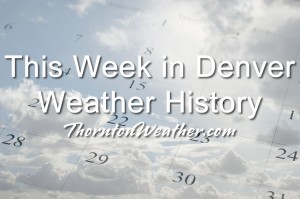
As we enter August the weather typical is a bit calmer as the atmosphere settles down. However our look back at this week in Denver weather history shows that Mother Nature can still visit plenty of excitement on us.
From the National Weather Service:
5
In 1881…the low temperature cooled to only 76 degrees…the record high minimum temperature for the month.
In 1889…southwest winds were sustained to 42 mph.
In 1918…hail pelted the city…but was light and caused no damage. Precipitation totaled 0.25 inch. Northwest winds were sustained to 31 mph.
In 1964…lightning struck two boys in Denver while playing ball. One was treated and released from the hospital…but the other boy suffered second degree electrical shock and cardiac arrest and was hospitalized in critical condition for several days.
In 1969…two tornadoes touched down briefly in an open field southeast of Buckley Field in Aurora. No damage was reported.
In 1970…heavy rain in the Indian Hills area in the foothills west of Denver caused flash flooding…which washed out roads and damaged other property. Hail accumulated to a 3 inch depth with stones up to golf ball size; however…most of the damage was from flooding.
In 1982…2.38 inches of rain fell in an hour in Arvada… Causing minor flooding on Ralston Creek. In Westminster… 1 1/2 inches of rain fell…causing damage to streets and culverts. In addition…lightning caused some minor power outages across metro Denver.
In 1983…very heavy thunderstorms hit the southern portion of metro Denver. Heavy rainfall…as much as 2.89 inches in 38 minutes…caused widespread street flooding in southeast Denver. Two feet of water covered a section of I-25. Hail up to golf ball size accompanied the storm in Littleton and Englewood…along with 60 mph winds.
In 1984…a heavy thunderstorm drenched Littleton with up to 2.35 inches of rain in an hour…along with small hail that piled up to 2 inches deep. Flood waters were up to 4 feet deep in parts of town with many basements flooded. There were some power outages caused by lightning.
In 1990…a thunderstorm dumped 1.25 inches of rain in 12 minutes near tower and smoky hill roads in southeast Aurora. Minor street flooding was reported in the area.
In 1992…a pilot reported two funnel clouds near Cheery Creek Reservoir. Both dissipated quickly. Dime size hail fell near Franktown.
In 1994…one inch diameter hail fell near Strasburg. No damage was reported.
In 1999…a dog kennel east of Denver International Airport… Was flooded when a small dam…upstream in Elbert County… Was breached. The floodwaters…up to 4 feet deep…washed away some 6-foot fences and other small buildings. Ten of the 70 dogs boarded at the kennel drowned.
In 2002…a mail carrier was struck by lightning as he inserted a key into a multi-unit mailbox in Bailey. The shock knocked the man back against the mail truck. He suffered minor injuries. Lightning struck a residence in Commerce City. The resulting fire destroyed the roof of a detached garage and damaged much of its contents. Hail as large as 1 3/4 inches in diameter pelted pine. One inch diameter hail fell in Arvada and southwest Denver. Heavy rain triggered a mudslide along U.S. Highway 285 near Bailey. Both lanes of traffic had to be closed until debris could be removed from the highway. Several residences in the Bailey and Glenisle areas were also flooded.
In 2004…heavy thunderstorm rainfall caused localized flash flooding in Virginia canyon near Idaho Springs. Sections of the Virginia Canyon Road had to be closed due to the floodwaters.
In 2008…a severe thunderstorm produced large hail…up to 1 1/4 inches in diameter…northeast of Parker. Several automobiles were damaged.
Continue reading August 5 to August 11 – This Week in Denver Weather History
